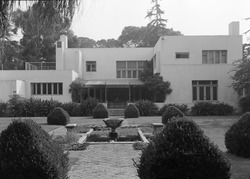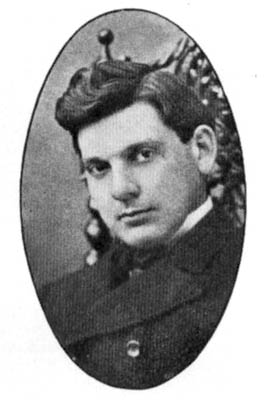Walter L. Dodge House facts for kids
Quick facts for kids Walter Luther Dodge House |
|
|---|---|
 |
|
| General information | |
| Type | Reinforced concrete |
| Architectural style | Early Modern |
| Location | 950 N. Kings Rd., West Hollywood, California |
| Coordinates | 35°27′38.41″N 119°52′58.13″W / 35.4606694°N 119.8828139°W |
| Construction started | 1914 |
| Completed | 1916 |
| Demolished | 1970 |
| Design and construction | |
| Architect | Irving Gill |
| Other information | |
| Number of rooms | 16 |
|
Walter Luther Dodge House
|
|
|
Formerly listed on the U.S. National Register of Historic Places
|
|
| NRHP reference No. | 68000058 |
| Significant dates | |
| Added to NRHP | 1968 |
| Removed from NRHP | 1970 |
The Walter L. Dodge House was a very special home in West Hollywood, California. It was designed by a famous architect named Irving Gill. The house was built in an Early Modern style, which was quite new and exciting at the time.
Many experts thought the Dodge House was one of the most important houses in America. It was even ranked among the top 15 most significant American houses! However, despite its fame, there were plans to tear it down. People tried hard to save it, but sadly, the house was completely demolished in 1970. Apartments were built in its place.
Contents
What Made the Dodge House Special?
The Dodge House had 16 rooms and was designed by Irving Gill in 1914. It was finished between 1914 and 1916. Walter Luther Dodge, who made a medicine for tired feet, owned the house.
This house was built using reinforced concrete. It mixed Spanish Mission style with modern ideas. It also had many cool new inventions for its time.
Cool Features and Technology
The Dodge House was full of amazing features:
- It had a garbage disposal in the kitchen sink.
- The garage had an automatic car wash.
- Doors were plain and flat, swinging on hidden hinges or sliding into walls.
- There was a central vacuum cleaning system.
- The doors were made of sheet metal.
- Inside, the wood surfaces were natural and simply polished.
- Skylights and windows let in lots of sunlight, making the rooms bright.
Architects loved the Dodge House because of its simple, clean design. It had sharp openings in plain walls, which looked very modern.
A House of Simple Beauty
In 1921, a magazine called House Beautiful wrote about the Dodge House. They said it had "bold and novel ideas" in its design. The house had no extra decorations, only what nature provided, like climbing vines.
The architect, Mr. Gill, believed that beauty should come from the building itself. He thought that nothing was more beautiful than a plain wall with cloud shadows moving across it. He also felt that a vine could perfectly frame a doorway or window.
The House's Story
From Retirement Home to School Property
Walter Dodge lived in the house after he retired until 1924. He then sold it for $125,000.
In 1939, the Los Angeles Board of Education bought the property. They planned to build a school there. However, by 1951, they decided a school wasn't needed in that area. The house was briefly used for an adult education program from 1961 to 1962.
Efforts to Save the House
In 1963, the Board of Education said the property was "extra" and not needed. The next year, the rules for the land changed. This meant many more apartments could be built there, making the land very valuable.
People who cared about architecture formed a group called the "Citizens' Committee to Save the Dodge House." They worked hard to protect the building. An architectural historian named Esther McCoy even made a film about the house in 1965 to help save it.
Because of this group, the Board of Education turned down a big offer for the land. The buyer wouldn't promise to save the house. The committee was given time to find a way to save it.
Why Saving It Was Hard
Many people didn't understand why the Dodge House was so special. Even though experts loved it, the public thought it looked ordinary. A writer in the Los Angeles Times explained that it looked too new to be historical. It didn't have the charm of older homes or the dramatic look of some modern ones.
From the outside, it seemed like a simple, two-story white house with a flat roof. It had plain rectangular windows and a few arches.
A Plan That Failed
In 1966, the Board of Education sold the property to a financier named Bart Lytton for $800,000. Lytton announced a plan to build apartments but also save the Dodge House. The Los Angeles Times even reported that the house was "Assured" to be saved.
But Lytton's business ran into trouble. He lost control of his company, and his plan to save the house fell apart. The Times noted that the Dodge House "lost its protector."
Efforts to stop the demolition continued. Famous architect Richard Neutra said the Dodge House was studied by architecture students worldwide. He warned that tearing it down would be "an international scandal." The Los Angeles Times begged people not to destroy such an important part of history.
The Sad Demolition
In November 1969, a lawsuit by the Citizens' Committee to stop the sale failed. The house was sold to Riviera Management Company. On February 9, 1970, during a heavy rainstorm, the new owner tore down the house.
Architect Kurt Meyer, who had fought for seven years to save it, said it was "like slashing a Rembrandt with a razor." Many people called it a "shameful chapter" in Los Angeles's history. The New York Times called it a "tragic commentary on how we throw our national heritage away."
Apartments were built on the site where the Dodge House once stood.
Why the Dodge House is Still Famous
Even after it was torn down, the Dodge House continued to receive praise. Here's what some experts said:
- Architectural historian William Jordy believed it was among the 15 most important American houses. He said it showed what modern architecture would become in Europe.
- The American Institute of Architects also ranked it among the top 15 most important homes in the U.S.
- Historian Henry-Russell Hitchcock called it a key example of Modernism in America.
- Lewis Mumford thought Irving Gill was as important as other famous architects like Louis Sullivan and Frank Lloyd Wright.
- Dr. Ludwig Glaeser from the Museum of Modern Art said Gill's ideas, especially in the Dodge House, are fully appreciated today.
- The New York Times called the Dodge House Gill's "masterwork."
- The Historic American Buildings Survey said it was a perfect example of Gill's talent. They called it a rare early example of the International Style and a great example of early reinforced concrete architecture.
- In 1965, Esther McCoy made a film called Dodge House, 1916 to try and save it. The film was found and fixed up in 2011. It is now one of the best ways to see what the building looked like.
In 1991, the Daily News wrote about how sad it was to lose the Dodge House. They said Gill designed for people, on a human scale. They also noted that most of his best work, including the Dodge House, was gone.
In December 2008, experts chosen by the Los Angeles Times picked the Walter Dodge House as one of the top ten houses in Southern California. The Times wrote that it's hard to believe this modern treasure was torn down for apartments. They noted that Gill's historic home now only lives on through photos, memories, and its reputation.
See also
- Irving Gill
- Horatio West Court, another building designed by Gill


